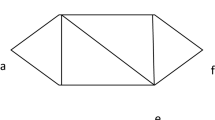Abstract
Elastic optical networks allow for a division of the optical spectrum into frequency slots, which can be combined to create channels with bandwidth defined by demand. Their flexibility provides greater spectral efficiency when compared with traditional optical networks with fixed grids. Traffic grooming strategies allow for even more efficiency in the use of network resources, reducing the number of guard bands and the utilization of transmitters and receivers. This work proposes a mechanism that influences the RMLSA algorithms causing a controlled level of spacing between the lightpaths. This makes it possible to expand lightpaths in the future to fulfill new customer requests through traffic grooming. The proposed mechanism does not require the use of specific traffic grooming or RMLSA algorithms, and it can be used in conjunction with existing solutions or future solutions. The experiments carried out show that the proposed mechanism reduces the bandwidth blocking ratio and the number of necessary transceivers, and also increases the request–lightpath ratio and energy efficiency in the network.









Similar content being viewed by others
References
Beyranvand, H., Salehi, J.A.: A quality-of-transmission aware dynamic routing and spectrum assignment scheme for future elastic optical networks. J. Lightwave Technol. 31(18), 3043–3054 (2013). https://doi.org/10.1109/JLT.2013.2278572
Christodoulopoulos, K., Tomkos, I., Varvarigos, E.A.: Elastic bandwidth allocation in flexible OFDM-based optical networks. J. Lightwave Technol. 29(9), 1354–1366 (2011). https://doi.org/10.1109/JLT.2011.2125777
Fontinele, A., Santos, I., Neto, J.N., Campelo, D.R., Soares, A.: An efficient IA-RMLSA algorithm for transparent elastic optical networks. Comput. Netw. 118, 1–14 (2017). https://doi.org/10.1016/j.comnet.2017.03.003
Load balancing, multipath routing and adaptive modulation with traffic grooming in elastic optical networks. Comput. Netw. 169, 107081 (2020). https://doi.org/10.1016/j.comnet.2019.107081
Johannisson, P., Agrell, E.: Modeling of nonlinear signal distortion in fiber-optic networks. J. Lightwave Technol. 32(23), 4544–4552 (2014). https://doi.org/10.1109/JLT.2014.2361357
Ju, M., Zhou, F., Xiao, S., Zhu, Z.: Power-efficient protection with directed\(p\)-cycles for asymmetric traffic in elastic optical networks. J. Lightwave Technol. 34(17), 4053–4065 (2016). https://doi.org/10.1109/JLT.2016.2590578
Khodashenas, S., Comellas, J., Spadaro, S., Perelló, J.: Dynamic source aggregation of subwavelength connections in elastic optical networks. Photon Netw. Commun. 26(2–3), 131–139 (2013). https://doi.org/10.1007/s11107-013-0415-1
Kozicki, B., Takara, H., Yonenaga, K., Jinno, M.: Efficient elastic optical path network for transmission beyond 100G. In: W. Weiershausen, B. Dingel, A.K. Dutta, A.K. Srivastava (eds.) Optical Metro Networks and Short-Haul Systems III, vol. 7959, pp. 151 – 159. International Society for Optics and Photonics, SPIE (2011). https://doi.org/10.1117/12.879847
Majumdar, P., Pal, A., De, T.: Extending light-trail into elastic optical networks for dynamic traffic grooming. Opt. Switch. Netw. 20, 1–15 (2016). https://doi.org/10.1016/j.osn.2015.10.005
Santos, I.: A spectrum spacing mechanism to enhance traffic grooming in elastic optical networks - dataset (2021). https://doi.org/10.17632/kj4hc2fcw9.1
Sato, K.: Recent developments in and challenges of elastic optical path networking. In: 37th European Conference and Exposition on Optical Communications, p. Mo.2.K.1. Optical Society of America (2011). https://doi.org/10.1364/ECOC.2011.Mo.2.K.1
Sone, Y., Watanabe, A., Imajuku, W., Tsukishima, Y., Kozicki, B., Takara, H., Jinno, M.: Bandwidth squeezed restoration in spectrum-sliced elastic optical path networks (slice). J. Opt. Commun. Netw. 3(3), 223–233 (2011). https://doi.org/10.1364/JOCN.3.000223
Vizcaíno, J.L., Ye, Y., López, V., Jiménez, F., Musumeci, F., Tornatore, M., Pattavina, A., Krummrich, P.M.: Protection in optical transport networks with fixed and flexible grid: Cost and energy efficiency evaluation. Opt. Switch. Netw. 11, 55–71 (2014). https://doi.org/10.1016/j.osn.2013.08.005
Wang, R., Bidkar, S., Meng, F., Nejabati, R., Simeonidou, D.: Load-aware nonlinearity estimation for elastic optical network resource optimization and management. IEEE/OSA J. Opt. Commun. Netw. 11(5), 164–178 (2019). https://doi.org/10.1364/JOCN.11.000164
Wang, R., Mukherjee, B.: Spectrum management in heterogeneous bandwidth optical networks. Opt. Switch. Netw. 11, 83–91 (2014). https://doi.org/10.1016/j.osn.2013.09.003
Wang, Y., Cao, X., Hu, Q., Pan, Y.: Towards elastic and fine-granular bandwidth allocation in spectrum-sliced optical networks. IEEE/OSA J. Opt. Commun. Netw. 4(11), 906–917 (2012). https://doi.org/10.1364/JOCN.4.000906
Wu, J., Ning, Z., Guo, L.: Energy-efficient survivable grooming in software-defined elastic optical networks. IEEE Access 5, 6454–6463 (2017). https://doi.org/10.1109/ACCESS.2017.2674963
Wu, Y., Hou, W., Guo, L., Liu, Y., Sun, Z.: Green grooming in elastic optical networks. Conference on optical fiber communication, technical digest series (2014). https://doi.org/10.1364/OFC.2014.W3A.3
Yan, L., Agrell, E., Wymeersch, H., Johannisson, P., Di. Taranto, R., Brandt-Pearce, M.: Link-level resource allocation for flexible-grid nonlinear fiber-optic communication systems. IEEE Photon. Technol. Lett. 27(12), 1250–1253 (2015). https://doi.org/10.1109/LPT.2015.2415586
Zhang, J., Ji, Y., Song, M., Zhao, Y., Yu, X., Zhang, J., Mukherjee, B.: Dynamic traffic grooming in sliceable bandwidth-variable transponder-enabled elastic optical networks. J. Lightwave Technol. 33(1), 183–191 (2015). https://doi.org/10.1109/JLT.2014.2383444
Zhang, S., Martel, C., Mukherjee, B.: Dynamic traffic grooming in elastic optical networks. IEEE J. Sel. Areas Commun. 31(1), 4–12 (2013). https://doi.org/10.1109/JSAC.2013.130102
Zhang, S., Zhu, M., Sun, Q., Li, G., Chen, B.: Effective utilization of transponder in elastic CD-ROADM optical networks with traffic grooming. In: 2018 Asia communications and photonics conference (ACP), pp. 1–3 (2018). https://doi.org/10.1109/ACP.2018.8595732
Author information
Authors and Affiliations
Corresponding author
Additional information
Publisher's Note
Springer Nature remains neutral with regard to jurisdictional claims in published maps and institutional affiliations.
Rights and permissions
About this article
Cite this article
Santos, I.G.S., Monteiro, J.A.S., Soares, A.C.B. et al. A spectrum spacing mechanism to enhance traffic grooming in elastic optical networks. Photon Netw Commun 42, 49–59 (2021). https://doi.org/10.1007/s11107-021-00943-x
Received:
Accepted:
Published:
Issue Date:
DOI: https://doi.org/10.1007/s11107-021-00943-x




